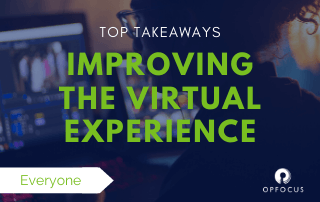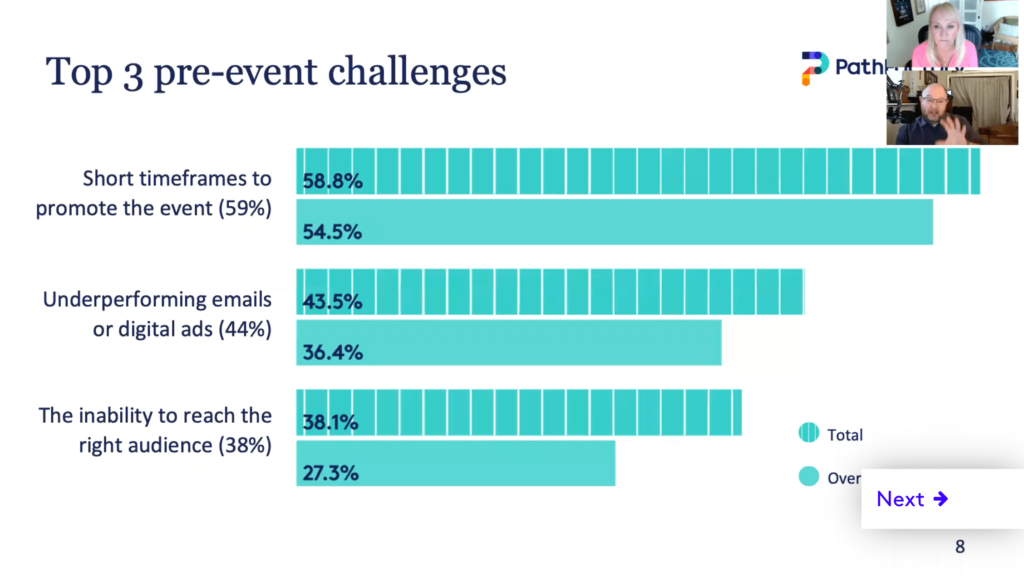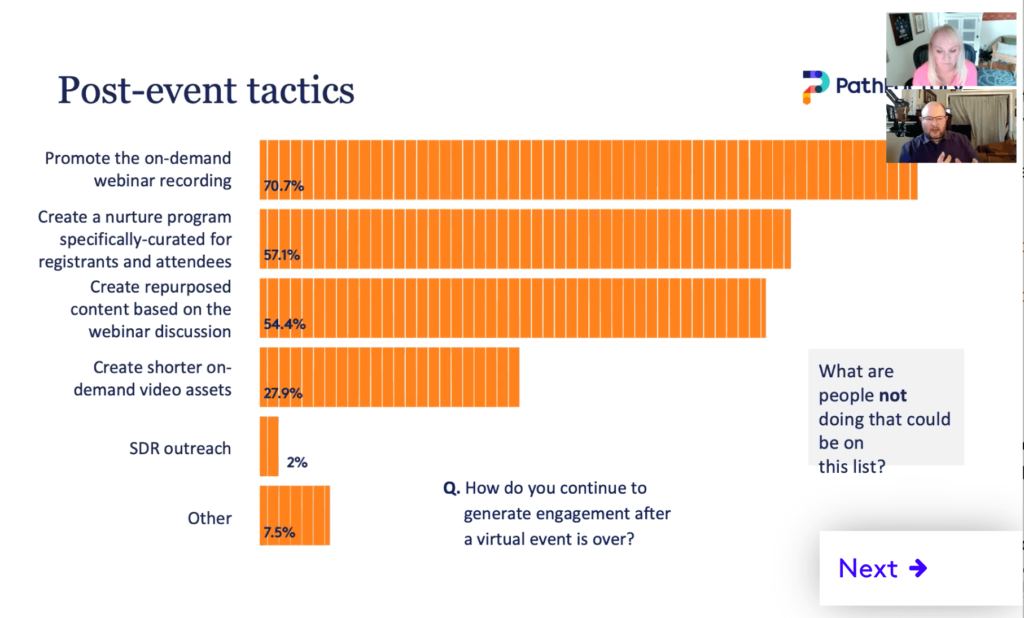Improving the Virtual Experience – Top Takeaways
 Corporate events have changed dramatically in the past 6 months. Companies that once spent money on events and booths are now shifting to virtual events. At the moment we aren’t even sure when in-person events will ever return. Helen Baptist and Matt Heinz believe that we may never fully go back, but instead, digital events will live on alongside their in-person counterparts. The two outlined the challenges and best practices that come along with today’s digital conferences in a recent PathFactory discussion. These are my top takeaways from their Improving the Virtual Experience webinar!
Corporate events have changed dramatically in the past 6 months. Companies that once spent money on events and booths are now shifting to virtual events. At the moment we aren’t even sure when in-person events will ever return. Helen Baptist and Matt Heinz believe that we may never fully go back, but instead, digital events will live on alongside their in-person counterparts. The two outlined the challenges and best practices that come along with today’s digital conferences in a recent PathFactory discussion. These are my top takeaways from their Improving the Virtual Experience webinar!
Pre Event
The first step to any event, virtual or in-person is to make the appropriate preparations. For virtual events, this includes determining the platform you’ll use, creating content, writing scripts, and of course, promoting the event. Generating registrations is often the most difficult step of the event. In fact, PayFactory finds that only 27.2% of respondents rate themselves as effective at generating registrations and attendees.
There are a number of factors that contribute to this low statistic. The audience you’re attempting to reach and the content you plan to present has a big impact on how difficult this will be. Through their research, the PathFactory team identified some of the leading challenges companies face during the Pre-event stage.

Pre-event challenges
- Short timeframes to promote events
- Shorter timeframes put a greater strain on internal channels as they struggle to create the material and content with tighter deadlines
- Underperforming emails or digital ads
- Finding the right messaging is challenging, especially with increased competition. Competing for the attention and time of your audience is difficult with so many virtual events
- The inability to reach the right audience
- A high number of registrations can be great but it’s ultimately meaningless if you’re not reaching the right people.
After identifying these challenges, Helen and Matt outlined a list of best practices your team will want to think about. Keeping these in mind will guide your team on how to avoid some of the challenges.
Pre-event best practices:
- Create an Editorial calendar and production schedule
- Outline and stick to a content and promotion schedule
- Set registration, attendance and on-demand viewing goals
- Develop goals ahead of time to gauge your success
- Ensure messaging is relevant and personalized
- Virtual events allow for very customized and targeted content
- Understand your audience
- Outline who it is you’re targeting and the type of content that appeals to them
In-Event
Your audience is looking for interactivity. There are opportunities where this is easier to manage virtually than in person. Virtual events let you connect with the entire audience using features like polls and Q&A. Although this is not a face to face interaction as people typically think of it, you’re can reach more people and allow everyone to contribute to the discussion. The types of presentations that people find engaging are more of a conversation than a presentation.

A question you may want to ask is how you plan to serve additional types of relevant content. This can include things like a PDF’s, whitepapers, and videos depending on your topic and audience. Sending items in the mail ahead of time is another way companies are creating this interaction.
Unfortunately, virtual events bring their own set of challenges as well. Helen and Matt outline a few common ones below.
In-Event Challenges:
- Lack of audience participation
- Lack of interactive audience tools
- Audience drop off mid-event
- Lack of the right data to measure engagement
- Low number of attendees
It’s recommended that you take some time to prepare for these challenges in advance. One idea mentioned is to prepare a backup stream in advance in case your internet or power cuts out. This backup stream can be used to keep the audience engaged. To overcome these challenges, Helen and Matt outlined best practices your team should keep in mind:
In-Event Best Practices
- Gamify the experience
- Make the experience as interactive and fun as possible!
- Get your audience involved
- Use things like polling and chat to get your participants engaged
- Identify what metrics you’ll track and how to utilize those metrics
- Plan for the data you’ll look at after the fact and how you’ll be using it.
- Utilize live event participation to identify interest and intent
- Take a look at who was most active during the event and determine if their interactions warrant a followup conversation.
Post Event
“Too often we think of an event as an event and not as part of an experience. If you haven’t been premeditated about thinking about what the followup strategy should be then your scrambling to figure out what that content will be.”
Matt outlined the importance of your post-event outreach when developing your strategy. This may in fact be the most important step since it will ultimately determine the leads and deals that come from your event.
Something you’ll want to think about is how you’ll reuse this content. An hour-long video is overwhelming but turning it into shorter clips makes it easier for your audience to digest. Tracking those that leave the event early and sending them the portion of the stream they missed is another great way to customize your followup and provide value. The more you can tailor this followup, the higher likelihood you’ll have at connecting with attendees.

Some challenges associated with the post-event followup include:
- Not knowing what content/topics individual attendees resonated/engage with the most
- The sales team not knowing who to follow-up with or what content to use
- Lacking the right content/message to utilize with attendees and registrants
Again, Helen and Matt covered a list of items your team should keep in mind to account for these challenges.
Some of their Post-Event Best practices include:
- Package content to make it easier to consume
- Do not make followup content include a form-fill or paywall
- Use tiers for your outreach to attendees
- Focus your outbound efforts to those that are were engaged
- Survey your audience
- Make sure you collect feedback from the audience to gauge interest
- Continue the conversation
- Always follow up with viewers in a meaningful way
Final Thoughts:
The two concluded by stating that using these best practices for each step of an event makes it easier to carry out and will increase viewer engagement. With virtual events becoming the new normal, its important to ensure your team can set itself apart. As OpFocus continues to deliver our own virtual events to the SaaS community, we’re excited to use these tips to provide an even more engaging experience.
Our next event is an open Ask Me Anything session around Strategy for Tech Stack Consolidation with our Sr Growth Advisor of the SaaS Growth Advisory Practice Jim Parker. Come join in the conversation and let us answer all your tech stack questions!



